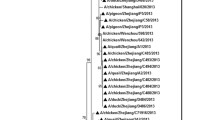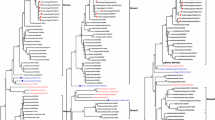Abstract
Surveillance of H9 avian influenza viruses in Korean live-poultry markets from September 2004 through October 2007 was carried out to investigate active reassortment between wild migratory birds and domestic poultry in Korea. Antigenic and phylogenetic analyses showed that most of the isolates belong to the previous Korean H9N2-like lineage and differ from the southeastern Chinese strains. Interestingly, the Ck/Korea/LPM77/06 group (genotype B) and Dk/Korea/LPM248/07 group (genotype C) showed unique properties distinct from those of other Korean H9N2 strains. Although the HA genes of these two groups belong to Korean H9N2-like lineage, the PA genes closely resemble those of the Chinese Y280-like lineage. In addition, the PB2 genes of the Dk/Korea/LPM248/07 group were closely related to those isolated from migratory birds. Several other isolates also clustered within the H9N2 B genotype, an indication that there are at least two predominant H9N2 influenza genotypes in Korea. Another isolate, Dk/Korea/LPM71/06, was identified as an H9N1 subtype, the first ever discovered in Korean live-poultry markets. These findings reveal that reassortment of Korean H9 influenza viruses has occurred frequently in live-poultry markets and may have been mediated by introduction of genetic material from viruses circulating among migratory wild birds to domestic birds. Consequently, the new dominant H9N2 genotypes have become established in Korean live-poultry markets through continued reassortment.






Similar content being viewed by others
References
Aiyar A (2000) The use of CLUSTAL W and CLUSTAL X for multiple sequence alignment. Methods Mol Biol 132:221–241
Alexander DJ (1982) Ecological aspects of influenza A viruses in animals and their relationship to human influenza: a review. J R Soc Med 75:799–811
Baker AT, Varghese JN, Laver WG, Air GM, Colman PM (1987) Three-dimensional structure of neuraminidase of subtypes N9 from an avian influenza virus. Proteins 2:111–117
Cameron KR, Gregory V, Banks J, Brown IH, Alexander DJ, Hay AJ, Lin YP (2000) H9N2 subtype influenza A viruses in poultry in Pakistan are closely related to the H9N2 viruses responsible for human infection in Hong Kong. Virology 278:36–41
Choi YK, Goyal SM, Farnham MW, Joo HS (2002) Phylogenetic analysis of H1N2 isolates of influenza A virus from pigs in the United States. Virus Res 87:173–179
Choi YK, Ozaki H, Webby RJ, Webster RG, Peiris JS, Poon L, Butt C, Leung YH, Guan Y (2004) Continuing evolution of H9N2 influenza viruses in southeastern China. J Virol 78:8609–8614
Choi YK, Seo SH, Kim JA, Webby RJ, Webster RG (2005) Avian influenza viruses in Korean live poultry markets and their pathogenic potential. Virology 332:529–537
Fouchier RAM, Munster V, Wallensten A, Bestebroer TM, Herfst S, Smith D, Rimmelzwaan GF, Olsen B, Osterhaus AD (2004) Characterization of a novel influenza A virus hemagglutinin subtype (H16) obtained from black-headed gulls. J Virol 79:2814–2822
Gonzalez S, Zürcher T, Ortin J (1996) Identification of two separate domains in the influenza virus PB1 protein involved in the interaction with the PB2 and PA subunit: a model for the viral RNA polymerase structure. Nucl Acids Res 24:4456–4463
Guan Y, Shortridge KF, Krauss S, Chin PS, Dyrting KC, Ellis TM, Webster RG, Peiris M (2000) H9N2 influenza viruses possessing H5N1-like internal genomes continue to circulate in poultry in southeastern China. J Virol 74:9372–9380
Guan Y, Shortridge KF, Krauss S, Webster RG (1999) Molecular characterization of H9N2 influenza viruses: were they the donors of the “internal” genes of H5N1 viruses in Hong Kong. Proc Natl Acad Sci USA 96:9363–9367
Guo YJ, Krauss S, Senne DA, Mo IP, Lo KS, Xiong XP, Norwood M, Shortridge KF, Webster RG, Guan Y (2000) Characterization of the pathogenicity of members of the newly established H9N2 influenza virus lineages in Asia. Virology 267:279–288
Hirst GK (1942) The quantitative determination of influenza virus and antibodies by means of red cell agglutination. J Exp Med 75:47–64
Hoffmann E, Stech J, Guan Y, Webster RG, Perez DR (2001) Universal primer set for the full-length amplification of all influenza A viruses. Arch Virol 146:2275–2289
Kawaoka Y, Webster RG (1988) Sequence requirements for cleavage activation of influenza virus hemagglutinin expressed in mammalian cells. Proc Natl Acad Sci 85:324–328
Koopmans M, Wilbrink B, Conyn M, Natrop G, van der Nat H, Vennema H, Meijer A, van Steenbergen J, Fouchier R, Osterhaus A, Bosman A (2004) Transmission of H7N7 avian influenza A virus to human beings during a large outbreak in commercial poultry farms in The Netherlands. Lancet 363:587–593
Lee CW, Song CS, Lee YJ, Mo IP, Garcia M, Suarez DL, Kim SJ (2000) Sequence analysis of the hemagglutinin gene of H9N2 Korean avian influenza viruses and assessment of the pathogenic potential of isolate MS96. Avian Dis 44:527–535
Lee YJ, Shin JY, Song MS, Lee YM, Choi JG, Lee EK, Jeong OM, Sung HW, Kim JH, Kwon YK, Kwon JH, Kim CJ, Webby RJ, Webster RG, Choi YK (2007) Continuing evolution of H9 influenza viruses in Korean poultry. Virology 359:313–324
Li KS, Xu KM, Peiris JS, Poon LL, Yu KZ, Yuen KY, Shortridge KF, Webster RG, Guan Y (2003) Characterization of H9 subtype influenza viruses from the ducks of southern China: a candidate for the next influenza pandemic in humans? J Virol 77:6988–6994
Liu H, Liu X, Cheng J, Peng D, Jia L, Huang Y (2003) Phylogenetic analysis of the hemagglutinin genes of twenty-six avian influenza viruses of subtype H9N2 isolated from chickens in China during 1996–2001. Avian Dis 47:116–127
Liu M, He S, Walker D, Zhou N, Perez DR, Mo B, Li F, Huang X, Webster RG, Webby RJ (2003) The influenza virus gene pool in a poultry market in South central china. Virology 305:267–275
Matrosovich M, Zhou N, Kawaoka Y, Webster RG (1999) The surface glycoproteins of H5 influenza viruses isolated from humans, chickens, and wild aquatic birds have distinguishable properties. J Virol 73:1146–1155
Mo IP, Song CS, Kim KS, Rhee JC (1997) An occurrence of non-highly pathogenic avian influenza in Korea. In: Swayne D, Slemons R (eds) Proceedings of the forth international symposium on avian influenza, United States Animal Health Association. Rose Printing Company, FL, pp 379–383
Naeem K, Ullah A, Manvell RJ, Alexander DJ (1999) Avian influenza A subtype H9N2 in poultry in Pakistan. Vet Rec 145:560
Palmer DF, Dowdle WR, Coleman MT, Schild GC (1975) Advanced laboratory techniques for influenza diagnosis, US Department of Health, Education and Welfare, Immunology Series, vol 6. Center for Disease Control, Atlanta, GA
Peiris JS, Yu WC, Leung CW, Cheung CY, Ng WF, Nicholls JM, Ng TK, Chan KH, Kai ST, Lim WL, Yuen KY, Guan Y (2004) Reemergence of fatal human influenza A subtype H5N1 disease. Lancet 363:617–619
Peiris M, Yuen KY, Leung CW, Chan KH, Ip PL, Lai RW, Orr WK, Shortridge KF (1999) Human infection with influenza H9N2. Lancet 354:916–917
Reed LJ, Muench H (1938) A simple method of estimating fifty per cent endpoints. Am J Hygiene 27:493–497
Rogers GN, Paulson JC, Daniels RS, Skehel JJ, Wilson IA, Wiley DC (1983) Single amino acid substitutions in influenza haemagglutinin change receptor binding specificity. Nature 304:76–78
Shortridge KF (1992) Pandemic influenza: a zoonosis? Semin Respir Infect 7:11–25
Song MS, Oh TK, Moon HJ, Yoo DW, Lee EH, Lee JS, Kim CJ, Yoo GJ, Kim HG, Choi YK (2008) Ecology of H3 avian influenza viruses in Korea and assessment of their pathogenic potentials. J Gen Virol 89:949–957
Tran TH et al (2004) Avian influenza A (H5N1) in 10 patients in Vietnam. N Engl J Med 18:1179–1188
Wang GP, Bushman FD (2006) A statistical method for comparing viral growth curves. J Virol Meth 135:118–123
Webster RG, Bean WJ, Gorman OT, Chambers TM, Kawaoka Y (1992) Evolution and ecology of influenza A viruses. Microbiol Rev 56:152–179
World Health Organization (2009) Pandemic (H1N1) 2009. In: Global alert and response. Available via http://www.who.int/csr/disease/swineflu/en/. Accessed 27 Aug 2009
Acknowledgment
This work was supported by a TBP grant (KGM311912) from Korean Research Council of Fundamental Science & Technology and KRIBB. We thank Taek-Kyu Oh for technical assistance.
Author information
Authors and Affiliations
Corresponding author
Additional information
The authors Ho Jin Moon and Min Suk Song contributed equally for this work.
Rights and permissions
About this article
Cite this article
Moon, H.J., Song, M.S., Cruz, D.J.M. et al. Active reassortment of H9 influenza viruses between wild birds and live-poultry markets in Korea. Arch Virol 155, 229–241 (2010). https://doi.org/10.1007/s00705-009-0577-4
Received:
Accepted:
Published:
Issue Date:
DOI: https://doi.org/10.1007/s00705-009-0577-4




